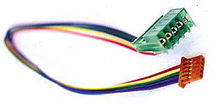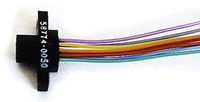Occasionally we are asked to manufacture items that are outside the
realm of conventional cable assemblies and wire harnesses. Such as small, miniature and tiny cable assembly for aerospace and medical and other OEM applications
Examples include
micro miniature (.050" pitch) connector manufacturing, small box
builds, electro-mechanical assemblies, epoxy potting, instrument or control panel assembly, and
assembly and test fixture fabrication.
 |
|---|
- Micro Miniature Connectors, Cable Assemblies, and Custom Connectors
- In-House Metal Fabrication, Machining, and Tooling Development
- Custom Mold Tooling, Metal Stamping, and Assembly Fixtures
- Custom Box Builds, Chassis Assembly, and Point-to-Point Wiring
- Custom Interconnect Assemblies, Wire Harness and Cable Assembly
- Quality Customer Service and Zero Defect Manufacturing


Any Specialty Cable small, miniature and tiny requests can use these applications
- Color Coded Cable- Non-PVC mini
- Custom Twisted Cable miniature assembly
- Flat Ribbon Cable small assemblies
- High Flex Cable small assembly
- High Speed Cable small cable assembly
- Jacketed and Shielded cable assemblies
- Slit Cable mini assemblies
Please contact us to discuss your specific interconnect needs, or custom wire harness and cable assembly requirements in miniature, small and tiny cable for all industrial and commercial applications. As a custom industrial cable assembly contractor, we service all OEM industries: aerospace, military, electronic, automotive, medical, telecommunications, computer, and others.
Cut and Stripped Wires for Consistent Lengths
Wire can be supplied already pre-cut to exact length and stripped on one or both ends. The cutting and stripping is usually performed on a machine, therefore you are assured of uniform lengths and consistent stripping.
By specifying partially stripped, or semi-stripped wires, the portion of the insulation being stripped (the "slug") will not be completely pulled from the end of the wire. The strands of the wire are thereby protected from fraying during handling and yet the slug can later be easily pulled off by hand. To preserve the lay of the strands, ideally the slug should be twisted slightly as it is pulled off. Semi-stripping is available for strip lengths as short as 2mm.
The length of the strip should be specified to match the contact or terminal that will be crimped on the end of the wire, or to the length dictated by the board thickness if soldering into a PCB. The strip length can be specified actually to within .02" or about 0.5 mm on our electronic cut-and-strip machinery, a level of precision which cannot be achieved by companies still using the old-style, pneumatic machines. However, it is good design practice to specify only as tight a tolerance as is required for the application. Remember that wire, and its insulation, can and will stretch during processing.
Here are some things to expect from our wire stripping department, in no particular order:
• Except for very short strip lengths, we will semi-strip your wires unless instructed otherwise. It is always prudent to request semi-stripped wires to protect the exposed strands, especially if the wire will not be crimped or tinned immediately.
• If one end is stripped a different length than the other, we will strive not to mix up the ends. We know from our own experience that sorting out jumbled wires is very annoying and wastes time.
• Some industry specifications allow nicked wires. Our policy is that nicked strands are unacceptable. The blades on our stripping machines open up slightly before pulling off the slug to minimize any chance of the blades contacting the strands.
• We will always bundle stripped wires in consistent quantities, such as 200 or 500 pcs. We do this to save you time in re-counting wires. This policy applies to wires that are at least 2" long and no larger than 12 AWG.
• Occasionally, some wires will not be completely stripped, with the slug still attached to the main portion of the insulation. We consider this a defect and will not knowingly ship this to you. Some production runs of wire can be more difficult to strip than others.
• Teflon insulated wire is more difficult to strip than conventional PVC insulated wire. To achieve clean strips we will likely use radius "V" blades or even die-cut blades. In addition, semi-stripped Teflon insulated wires do not always retain their slugs. In any case, stripping Teflon insulated wire requires greater care and may entail slightly higher charges.
• In rare cases where the customer supplies the wire, we will insist that the wire is supplied on reels with at least a 4" diameter core. When wound tightly, the wireÕs "memory" will tend to make it coil up and feed improperly into our machines.
• When ordering many different colors and lengths of wire, try to assign a part number or bill of material reference to each batch. Once cut and stripped, wires of the same color but slightly different lengths or strip lengths can appear identical. At the minimum, we will mark each batch with the length, strip length of end 1, strip length of end 2, color, gauge, stranding, UL style, and quantity.
Crimping a Cable for Wire Harness or Cable Assembly
Crimping is one of the most fundamental processes in creating a wire harness or cable assembly. We at Centerline understand its importance, and take great pains to ensure that all crimps are properly formed.
Basically, crimping is the mechanical attachment of a contact or terminal onto the stripped end of a wire. The attachment is typically achieved by using compressive force to fold the "crimp wings" or crimp barrel of a contact around the strands of wire under sufficient pressure to form a cold weld.
Having formed the crimp, one can then insert the contact(s) into an insulator (either a housing or connector body) so as to form one half of a connector pair. Note that the active connecting element is the contact, while the housing or connector body merely serves to hold the contacts in position for proper mating.
The process of crimping requires the use of a forming die or die set. The die set is designed to accomodate a specific contact or terminal as well as a specific size of wire. Using a too-small die set can result in severing the wire strands or weakening its tensile strength. Using a die set that is too large will risk the possibility of the strands pulling out of the crimp, or of creating a mechanical bond that has a high electrical resistance.
Centerline Engineering employs the proper die sets for every crimp. Our applicator tooling is adjustable to accomodate different gauges of wire, or multiple wires in a single crimp. Prior to and during crimping of a production lot, we check the crimp height of the crimp and also tensile test the wire-contact combination to the manufacturer's recommended specifications.
There are several important aspects of a good crimp. Please refer to the following illustration:
a) bellmouth: must be sufficient to prevent strands from being cut
b) wire brush: must be visible but not excessive
c) wire crimp: not too tight, not too loose, and include all the strands
d) insulation crimp: just sufficient to serve as strain relief
e) crimp "window": both wire strands and insulation should be visible in this window
f) strip length: must be correct to match with contact or terminal dimensions